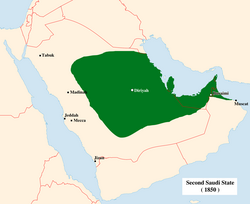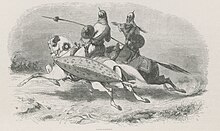| Second Saudi Stateالدولة السعودية الثانية (Arabic) Emirate of Nejd إمارة نجد (Arabic) | |||||||||||||
|---|---|---|---|---|---|---|---|---|---|---|---|---|---|
| 1824–1891 | |||||||||||||
 Flag
Flag | |||||||||||||
 Borders of the Emirate of Nejd by 1850 Borders of the Emirate of Nejd by 1850 | |||||||||||||
| Capital | Riyadh | ||||||||||||
| Common languages | Najdi Arabic | ||||||||||||
| Government | Absolute monarchy | ||||||||||||
| Imam | |||||||||||||
| • 1819–1834 | Turki bin Abdullah (first) | ||||||||||||
| • 1889–1891 | Abdul Rahman bin Faisal (last) | ||||||||||||
| History | |||||||||||||
| • Reconquest of Riyadh | 1824 | ||||||||||||
| • Battle of Mulayda with the Al Rashid | 24 January 1891 | ||||||||||||
| |||||||||||||
| Today part of | Saudi Arabia Qatar United Arab Emirates Oman | ||||||||||||
The Emirate of Nejd or Imamate of Nejd, also known as the second Saudi state was existing between 1824 and 1891 in Nejd, the regions of Riyadh and Ha'il of what is now Saudi Arabia. Saudi rule was restored to central and eastern Arabia after the Emirate of Diriyah, the first Saudi state, having previously been brought down by the Ottoman Empire's Egypt Eyalet in the Ottoman–Wahhabi War (1811–1818).
The second Saudi period was marked by less territorial expansion and less religious zeal, although the Saudi leaders continued to be called Imam and still employed Wahhabist religious scholars. Turki bin Abdullah bin Muhammad's reconquest of Riyadh from Egyptian forces in 1824 is generally regarded as the beginning of the Second Saudi State. Severe internal conflicts within the House of Saud eventually led to the dynasty's downfall at the Battle of Mulayda in 1891, between the forces loyal to the last Saudi imam, Abdul Rahman ibn Faisal ibn Turki, and the Rashidi dynasty of Ha'il.
History
The first Saudi to attempt to regain power after the fall of the Emirate of Diriyah in 1818 was Mishari bin Saud, a brother of the last ruler in Diriyah, Abdullah ibn Saud but he was soon captured by the Egyptians and killed. In 1824, Turki ibn Abdullah ibn Muhammad, a grandson of the first Saudi imam Muhammad ibn Saud who had managed to evade capture by the Egyptians, was able to expel Egyptian forces and their local allies from Riyadh and its environs and is generally regarded as the founder of the second Saudi dynasty as well as the ancestor of the kings of modern-day Saudi Arabia. He made his capital in Riyadh and was able to enlist the services of many relatives who had escaped captivity in Egypt, including his son Faisal bin Turki.
Turki was assassinated in 1834 by Mishari bin Abdul Rahman, a distant cousin. Mishari was soon besieged in Riyadh and later executed by Faisal, who went on to become the most prominent ruler of the Saudis' second reign. Faisal, however, faced a re-invasion of Najd organised by Mehmet Ali. The local population was unwilling to resist, and Faisal was defeated and taken to Egypt as a prisoner for the second time in 1838.

The Egyptians installed Khalid bin Saud, who had spent many years in the Egyptian court, as ruler in Riyadh and supported him with Egyptian troops. Khalid was the last surviving brother of Abdullah bin Saud bin Abdulaziz, a great-grandson of Muhammad ibn Saud. However, following the 1840 Convention of London imposed by European powers, the Egyptians withdrew their military presence in the Arabian Peninsula, leaving Khalid with minimal support. Perceived by most locals as little more than an Egyptian governor, Khalid was toppled soon afterwards by Abdullah bin Thunayan, of the collateral Al Thunayan branch.
To restore equilibrium and counteract British influence, Mehmet Ali directed his aides to empower Faisal bin Turki, who had been imprisoned during his campaign in Najd, facilitating his escape from Egypt. Faisal's return was seen as crucial for maintaining balance, given his rightful claim to rule in Najd, which had been under Abdullah bin Thunayan's control. Faisal's relationship with Muhammad Ali appears to have been pragmatic, governed by mutual interests.
Assisted by the Al Rashid rulers of Ha'il, Faisal swiftly eliminated his rival and retook Riyadh, resuming his rule. He later appointed his son Abdullah bin Faisal bin Turki as heir apparent, and divided his dominions among his three sons Abdullah, Saud, and Muhammad. This time Faisal recognised Ottoman suzerainty and paid an annual tribute; in exchange he was recognised as “ruler of all the Arabs” by the Ottomans.
After regaining control, Faisal consolidated his power by subduing opposition tribes in Najd and forging alliances. This centralized authority required financial resources, prompting Faisal to target Al-Ahsa, Qatif, and Saihat—key economic hubs. He imposed his control over these regions, ensuring a steady flow of funds to his treasury by imposing what was termed zakat, though it functioned as a tax in contemporary terms.
Faisal's ambitions extended beyond these territories. In 1847, he attempted to intervene in Bahrain, exploiting internal conflicts within the ruling family. Although unsuccessful in capturing Bahrain, he settled for a peace agreement that included a tribute payment. His inability to seize Bahrain was primarily due to attacks on the Al-Qassim Province by Muhammad bin Awn and Khalid bin Saud, and the firm stance of the British government against Saudi expansion in the Persian Gulf. The British, who had substantial interests in the region, closely monitored Faisal's movements. Their support for the Bahraini sheikh and their strategic positions in the Gulf influenced the broader regional dynamics.
In the aftermath of the Battle of Mesaimeer in Qatar in June 1851, Faisal gained temporary dominion over Qatar, which was previously under Bahraini control. However, a peace agreement brokered by Saeed bin Tahnun Al Nahyan on 25 July stipulated that Ali bin Khalifa, the Bahraini representative in Qatar, would remit 4,000 German krones annually as zakat to Faisal, while the latter agreed to restore Al Bidda Fort to Ali bin Khalifa and to abstain from interference in Qatari affairs.
Upon Faisal's death in 1865 the state began to decline due to the fact that different rulers, namely Abdullah, Saud, Abdul Rahman and Saud's sons, became the head of the state until 1891. Immediately following the death of Faisal, Abdullah assumed rule in Riyadh but was soon challenged by his brother, Saud. The two brothers fought a long civil war, in which they traded rule in Riyadh several times. A vassal of the Saudis, Muhammad bin Abdullah Al Rashid of Ha'il took the opportunity to intervene in the conflict and increase his own power. Gradually, Al Rashid extended his authority over most of Najd, including the Saudi capital, Riyadh. He finally expelled the last Saudi leader, Abdul Rahman bin Faisal, from Najd after the Battle of Mulayda in 1891.
Rulers
Abdul Rahman bin Faisal, last ruler of the Emirate.
- Imam Turki bin Abdullah bin Muhammad (first time) 1819–1820
- Imam Turki bin Abdullah bin Muhammad (second time) 1824–1834
- Imam Mishari bin Abdul Rahman bin Mishari 1834–1834 (Usurper)
- Imam Faisal bin Turki bin Abdullah Al Saud (first time) 1834–1838
- Imam Khalid bin Saud bin Abdulaziz Al Saud 1838–1841
- Imam Abdullah bin Thunayan bin Ibrahim bin Thunayan bin Saud 1841–1843
- Imam Faisal bin Turki bin Abdullah Al Saud (second time) 1843–1865
- Imam Abdullah bin Faisal bin Turki (first time) 1865–1871
- Imam Saud ibn Faisal 1871–1871 (first time)
- Imam Abdullah bin Faisal bin Turki (second time) 1871–1873
- Imam Saud bin Faisal (second time) 1873–1875
- Imam Abdul Rahman bin Faisal (first time) 1875–1876
- Imam Abdullah bin Faisal bin Turki (third time) 1876–1889
- Imam Abdul Rahman bin Faisal (second time) 1889–1891
See also
References
- Front Cover George Walter Prothero, Great Britain. Foreign Office. Historical Section. Peace Handbooks: Turkey in Asia (II), no. 61–66. H. M. Stationery Office, 1920. Pp. 20
- Madawi al Rasheed (April 2010). A History of Saudi Arabia. Cambridge University Press. p. 25. ISBN 9780521761284. Retrieved 18 February 2017.
- ^ Safran, Nadav. Saudi Arabia: The Ceaseless Quest for Security. Cornell University Press. 2018.
- Al-Ali, Khalid bin Ghanem (2024). الُهَُوِّيَة الَوَطنّيّة الَقَطرّيّة [Qatari National Identity] (PDF) (in Arabic). Ministry of Culture (Qatar). p. 52.
- ^ Al-Ali, Khalid bin Ghanem (2024). الُهَُوِّيَة الَوَطنّيّة الَقَطرّيّة [Qatari National Identity] (PDF) (in Arabic). Ministry of Culture (Qatar). p. 53.
- Rahman, Habibur (2006). The Emergence Of Qatar. Routledge. p. 69. ISBN 978-0710312136.
- Mohamed Zayyan Aljazairi (1968). Diplomatic history of Saudi Arabia, 1903-1960's (PDF) (PhD thesis). University of Arizona. p. 13. Retrieved 26 November 2020.
- ^ Roby C. Barrett (June 2015). "Saudi Arabia: Modernity, Stability, and the Twenty-First Century Monarchy" (Report). Joint Special Operations University. p. 22. Archived (PDF) from the original on 8 May 2021. Retrieved 8 February 2021.
External links
- Second State of Saudi Arabia
- "The first and second Saudi states" Saudi Aramco World, January/February 1999, pp 4–11
| Saudi Arabia articles | |||||||||
|---|---|---|---|---|---|---|---|---|---|
| History |  | ||||||||
| Geography | |||||||||
| Politics |
| ||||||||
| Economy | |||||||||
| Society |
| ||||||||
23°0′N 45°30′E / 23.000°N 45.500°E / 23.000; 45.500
Categories:- 19th century in the Arabian Peninsula
- 19th-century establishments in the Arabian Peninsula
- 1824 establishments in Asia
- 1891 disestablishments in Asia
- Former Arab states
- Former countries in West Asia
- History of Najd
- House of Saud
- Ottoman Arabia
- States and territories established in 1824
- States and territories disestablished in 1891
- Former emirates